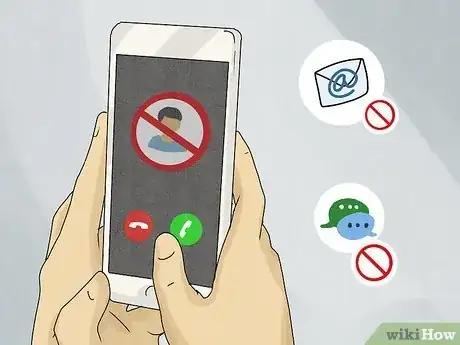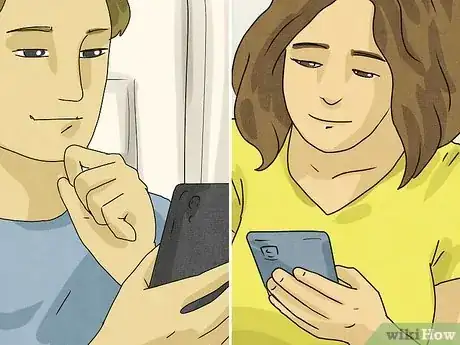This article was written by Liana Georgoulis, PsyD and by wikiHow staff writer, Amber Crain. Dr. Liana Georgoulis is a Licensed Clinical Psychologist with over 10 years of experience, and is now the Clinical Director at Coast Psychological Services in Los Angeles, California. She received her Doctor of Psychology from Pepperdine University in 2009. Her practice provides cognitive behavioral therapy and other evidence-based therapies for adolescents, adults, and couples.
There are 7 references cited in this article, which can be found at the bottom of the page.
This article has been viewed 55,401 times.
If you want to reconnect with a fearful avoidant ex, you're probably wondering what the best approach is. Someone with a fearful avoidant attachment style won't respond to grand gestures, emotional apologies, or attempts to make them jealous—so what are your options? In this article, we'll explain how to make a fearful avoidant miss you, reforge your bond, and move forward together. We'll also touch on the underlying causes so you can better understand your partner's attachment style.
This article is based on an interview with our licensed clinical psychologist, Liana Georgoulis, Psy.D. Check out the full interview here.
Steps
Go no contact for a while.
-
Fearful avoidants need time and space before they start missing you. In the past, you probably noticed that the more you pushed to get closer to your ex, the more they withdrew from you.[1] X Trustworthy Source HelpGuide Nonprofit organization dedicated to providing free, evidence-based mental health and wellness resources. Go to source This is very common behavior in fearful avoidants. It may sound counter-intuitive, but if you want to get back together, make yourself scarce by going no contact. That means no texting, calls, or DMs.
- Give your ex a heads up if you don’t want to blindside them. You might say, “I think the best way for both of us to get the space we need is to stop communicating for a while. I would love to reconnect once we've both calmed down and processed our emotions, through.”
- If your ex reaches out during the “no contact” period, it’s best to acknowledge them. If you ignore them, they may feel rejected or ashamed, which will make them avoid you in the future.[2] X Research source
Keep a low profile on social media.
-
This is a subtle yet effective way to make yourself scarce. A fearful avoidant will use social media as an anonymous way to check up on you after a breakup. Try to limit your posts or stop posting entirely so they have no information to go on. Creating a little mystery will make them wonder what you're doing, and that’s when a fearful avoidant is most likely to start missing you.[3] X Research source
- You can always set your social media profiles to private or even block your ex, but these strategies may backfire with a fearful avoidant. Blatantly snubbing your ex could make them feel rejected.
Focus on self-care.
-
Taking care of yourself will put you in a more positive headspace. Breakups are hard and most people struggle with low self-esteem after going through one. Use the time away from your ex to prioritize your physical and mental health through self-care. Being in a positive state of mind will up your chances of getting back together with a fearful avoidant.[4] X Research source You can do things like:
- Start a new exercise routine
- Pursue your hobbies and interests
- Eat a healthy and nutritious diet
- Journal regularly to process your emotions
- Use positive affirmations every day
- Get 7-9 hours of sleep every night[5]
X
Expert Source

Licensed Psychologist Expert Interview. 14 April 2021.
Reconnect via text or social media.
-
Use a non-confrontational platform to reopen lines of communication. It’s unusual for a fearful avoidant to reach out first (even if they secretly want to), so you’ll have to make the first move after a period of no contact. It’s important to ease back in slowly, so start with something low-key, like a text or DM. Keep the message short and light to avoid alienating or scaring them.[6] X Research source You might say:
- "Hey! I just wanted to reach out and see how you’re doing these days. Lmk..."
- "Drove by your favorite taco truck today and thought of you. Hope you're well!"
Bring up good memories.
-
Nostalgia can be a powerful motivator for fearful avoidants. After a period of no contact, people with this attachment style usually start to assume that the relationship is truly over—and that's when the nostalgia kicks in. If you want to make your ex miss you, play up the nostalgia factor by bringing up a few of your relationship’s greatest hits.[7] X Research source You might say:
- ”Remember that night we picnicked on the beach? We brought my telescope and looked at the stars. That’s one of my favorite memories.”
- ”I heard our song the other day. It immediately took me back to that night when we put it on repeat and danced for hours. Love that memory.”
Boost their ego with compliments.
-
A fearful avoidant craves appreciation and approval. This attachment style is rooted in low self-esteem developed as a child, probably as a response to mixed signals they received from a parent/caregiver.[8] X Expert Source

Licensed Psychologist Expert Interview. 14 April 2021. They felt confused and let down by these mixed signals, and they dealt with that anxiety by withdrawing. Deep down, though, a fearful avoidant longs for connection and deeply appreciates loving encouragement.[9] X Research source You might say:- "I knew you’d ace that test, Erika! You’ve always been brilliant."
- "You play the piano beautifully. I'm so impressed by your talent."
Be positive.
-
This offsets a fearful avoidant's tendency to focus on the negative. People with this attachment style live in a constant state of anxiety and fear, which makes them feel understandably negative about things. If you want to get back together with a fearful avoidant, avoid doing or saying anything to make their anxiety worse. The goal is to make them feel safe around you, so remember to be calm, kind, and upbeat.[10] X Research source
- Speak to them in a soothing tone of voice.
- Point out the silver lining when something bad happens.
- Support their feelings, but try to share a more positive perspective.[11]
X
Expert Source

Licensed Psychologist Expert Interview. 14 April 2021.
Maintain your independence.
-
Fearful avoidants seek out partners who do their own thing. As you're reconnecting with your ex, be sure to keep up with your solo activities and friendships. Get out there and keep living your best life! Pushing for alone time and hanging out too frequently will scare off a fearful avoidant. They value their own freedom very much, and they’re drawn to partners who can be equally independent.[12] X Trustworthy Source HelpGuide Nonprofit organization dedicated to providing free, evidence-based mental health and wellness resources. Go to source Do things like:
- Hang out with your family and friends regularly
- Make time for your hobbies and interests
- Focus your energy on school or your job
Take things slow.
-
If a fearful avoidant feels rushed or overwhelmed, they'll withdraw. This is the key thing to remember about fearful avoidants: pushing for closeness ultimately pushes them away. Move at their pace and wait for them to signal that they're ready to forward with the relationship. If they react poorly when you broach the subject, pull back right away so you don't scare them off.[13] X Research source
- For example, if you mention getting back together and they immediately shut down, back off for now. They aren’t ready yet.[14] X Research source
Empathize with your ex.
-
Put yourself in their shoes to truly understand their feelings. Imagine what it's like to feel scared, anxious, and afraid to get close to another human being. This is what life is like for a fearful avoidant, and it can be difficult for a person to endure. It's easy to get upset with your ex for shutting down or withdrawing, but remember that the problem isn't personal and try to find compassion for them.[15] X Research source
- Your ex developed fearful avoidant tendencies because something unpleasant happened in their childhood that made them this way. If you've never talked about that together, consider bringing it up now so it's out there on the table. If they aren't ready to talk, that's okay.
Talk about what wrong in the relationship.
-
That way, you can fix the issues and move forward as a team. Fearful avoidants usually back out of relationships because they feel overwhelmed, unheard, or distrustful. If you're considering getting back together, the best solution is to sit down with your partner and nail down exactly what went wrong. Keep in mind that they may try to avoid this conversation, so don't force it. They'll talk when they're ready.[16] X Research source To start a dialogue, you might ask questions like:
- Do you have specific needs that I wasn't meeting the first time around?
- What aspects of our relationship made you uncomfortable or unhappy?
- What behaviors can I work on to make you more comfortable in the future?
Be patient with them.
-
Reconnecting with a fearful avoidant takes time—and that's okay. You probably want to get back together as soon as possible (which is understandable), but try to remember that patience is the key to successfully interacting with a fearful avoidant. Make it clear to your partner that you’re here for them. You can provide comfort and support if they need it, but give them all the space they need until they feel ready.[17] X Research source
Accept your differences.
-
You can’t change their attachment style—only they can do that. You can have a successful relationship with a fearful avoidant, but remember that they can't change overnight. Attachment styles are formed early in life, so they’re deeply ingrained.[18] X Research source
- Couples therapy can help you understand each other better and work through attachment style differences.[19] X Trustworthy Source Greater Good Magazine Journal published by UC Berkeley's Greater Good Science Center, which uses scientific research to promote happier living Go to source
You Might Also Like
 16 Ways to Tell If Your Ex Still Likes You (Even If They Say They Don’t)
16 Ways to Tell If Your Ex Still Likes You (Even If They Say They Don’t)





 How to Get Your Ex Back Quickly
How to Get Your Ex Back Quickly


 Should You Text Your Ex Happy Birthday?
Should You Text Your Ex Happy Birthday?
 What to Do If You Run Into Your Ex
What to Do If You Run Into Your Ex

References
- ↑ https://www.helpguide.org/articles/relationships-communication/attachment-and-adult-relationships.htm
- ↑ https://www.youtube.com/watch?v=bWZ2TCd0glg&t=149s
- ↑ https://www.psychologytoday.com/us/blog/the-freedom-change/201504/fear-intimacy-and-closeness-in-relationships
- ↑ https://www.marriage.com/advice/mental-health/how-to-communicate-with-an-avoidant-partner/
- ↑ Liana Georgoulis, PsyD. Licensed Psychologist. Expert Interview. 14 April 2021.
- ↑ https://www.marriage.com/advice/mental-health/how-to-communicate-with-an-avoidant-partner/
- ↑ https://www.marriage.com/advice/mental-health/how-to-communicate-with-an-avoidant-partner/
- ↑ Liana Georgoulis, PsyD. Licensed Psychologist. Expert Interview. 14 April 2021.
- ↑ https://www.psychologytoday.com/us/blog/the-freedom-change/201505/come-here-go-away-the-dynamics-fearful-attachment
- ↑ https://www.marriage.com/advice/mental-health/how-to-communicate-with-an-avoidant-partner/
- ↑ Liana Georgoulis, PsyD. Licensed Psychologist. Expert Interview. 14 April 2021.
- ↑ https://www.helpguide.org/articles/relationships-communication/attachment-and-adult-relationships.htm
- ↑ https://www.psychologytoday.com/us/blog/the-freedom-change/201505/come-here-go-away-the-dynamics-fearful-attachment
- ↑ https://www.psychologytoday.com/us/blog/the-freedom-change/201504/fear-intimacy-and-closeness-in-relationships
- ↑ https://www.psychologytoday.com/us/blog/the-freedom-change/201505/come-here-go-away-the-dynamics-fearful-attachment
- ↑ https://www.psychologytoday.com/us/blog/the-freedom-change/201505/come-here-go-away-the-dynamics-fearful-attachment
- ↑ https://www.psychologytoday.com/us/blog/the-freedom-change/201505/come-here-go-away-the-dynamics-fearful-attachment
- ↑ https://www.psychologytoday.com/us/blog/the-freedom-change/201504/fear-intimacy-and-closeness-in-relationships
- ↑ https://greatergood.berkeley.edu/article/item/how_to_stop_attachment_insecurity_from_ruining_your_love_life
About This Article


























































